The below videos will walk you through the basics of how to start stitching a downloadable pattern. For more information on beginning hand embroidery, check out the article All You (Really) Need to Begin Hand Embroidery.
1 - Review of Materials
Hand embroidery requires just a handful of materials, including embroidery floss (I recommend using 6-strand DMC embroidery floss), an embroidery hoop, fabric (cotton or a cotton blend is great to start), an embroidery needle (size 5 is pretty versatile), a water erasable pen for pattern transfer (works best on light-colored fabric), and your pattern. A small scissors is helpful too. All of these supplies should be available at your local craft store.
2 - Tracing Your Pattern
There are several different ways you can transfer your pattern, but using a water erasable pen is great for starters. When you are done stitching, simply rinse out the blue ink under cold water, and let your embroidery dry flat on a clean towel.
3 - Putting Fabric in Your Hoop
I find wooden embroidery hoops easiest to use, though they are available in plastic as well. Try different types to see what you like best.
4 - About 6-Strand Cotton Embroidery Floss
DMC is the most well-known manufacturer of embroidery floss. Their floss comes in a wide range of colors and dye lots are matched beautifully for a consistent appearance. Six-strand cotton embroidery floss comes in a skein and is made of six strands which can be used all together, or separated for narrower stitches.
5 - How to Split Your Embroidery Floss
Use between four and six strands of the floss for thicker stitches. Use between one and three strands to stitch finer details. Experiment with splitting your six-strand embroidery floss and stitching with varying numbers of strands to see how they affect your stitches.

